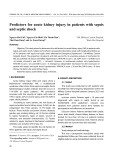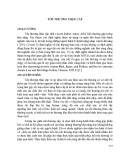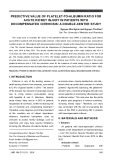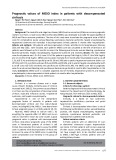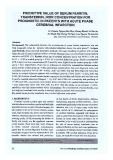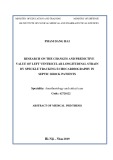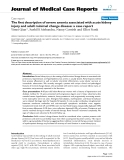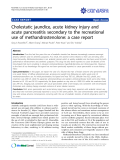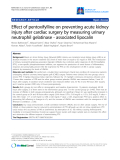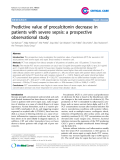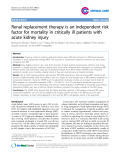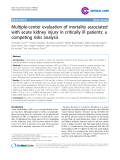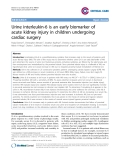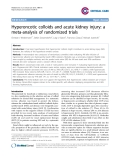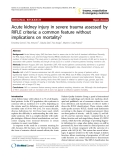
169
JOURNAL OF MEDICAL RESEARCH
JMR 184 E15 (11) - 2024
Corresponding author: Nguyen The Bao
Can Tho University of Medicine and Pharmacy
Email: drntbao12345@gmail.com
Received: 02/10/2024
Accepted: 17/10/2024
I. INTRODUCTION
PREDICTIVE VALUE OF PLATELET-TO-ALBUMIN RATIO FOR
ACUTE KIDNEY INJURY IN PATIENTS WITH
DECOMPENSATED CIRRHOSIS: A DOUBLE-CENTER STUDY
Nguyen Nhu Nghia and Nguyen The Bao
Can Tho University of Medicine and Pharmacy
This study aims to evaluate the value of the platelet-to-albumin ratio (PAR) in predicting acute kidney
injury (AKI) in patients with decompensated cirrhosis. A descriptive cross-sectional analysis was conducted at
multiple centers on 295 patients with decompensated cirrhosis, treated at the Department of Gastroenterology
- Can Tho Central General Hospital and the Department of Gastroenterology - Bac Lieu General Hospital
from June 2019 to May 2021. The results showed that the average age of the study subjects was 60.0 ±
12.5 years old, with a male/female ratio of 3/2. The average albumin level was relatively low, at 27.18 ± 6.29
g/L. The median platelet count was 73 x 109/L. The median platelet-to-albumin ratio was 2.99. The incidence
of acute kidney injury in patients with decompensated cirrhosis was 33.9%. At a cut-off point of the serum
platelet-to-albumin ratio ≥ 3.64, the predictive value for the incidence of acute kidney injury in patients with
decompensated cirrhosis was recorded with an area under the ROC curve (AUC) of 96.7% (95%CI: 95% - 98%).
Keywords: Platelet-to-albumin ratio, predictive value, acute kidney injury, decompensated cirrhosis.
Cirrhosis is one of the leading causes of
death among chronic liver diseases, accounting
for 2.4% of global deaths in 2019.1 The burden
of the disease has become increasingly severe
due to rising alcohol consumption along
with hepatitis B and C infections. Notably,
acute kidney injury occurs in 60% of patients
hospitalized for cirrhosis, further increasing the
risk of mortality and complicating treatment.2
Therefore, early diagnosis and timely treatment
of this condition are of utmost importance.
However, traditional biomarkers used by
clinicians to assess kidney damage, such as
creatinine and urea, face several limitations,
including the influence of external factors such
as muscle mass, muscle metabolism, and diet –
factors that are particularly common in cirrhotic
patients.3 Against this backdrop, the platelet-to-
albumin ratio, a recently emerging indicator, has
shown potential in monitoring inflammation and
nutritional status.4 This ratio also has the ability
to predict poor prognosis in various conditions,
including kidney injury.5 Therefore, our study
was conducted with the aim of evaluating the
value of the PAR in predicting AKI in patients
with decompensated cirrhosis.
II. MATERIALS AND METHODS
1. Subjects
All patients with decompensated cirrhosis
treated at the Department of Gastroenterology
– Can Tho Central General Hospital and Bac
Lieu General Hospital from June 2019 to May
2021.
Inclusion criteria
- Patients were diagnosed with





